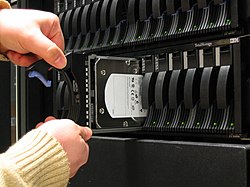
Back Canvi en calent Catalan Hot swapping Czech Hot-swap Danish Hot Swapping German Cambio en caliente Spanish Käigultvahetus Estonian اتصال گرم Persian Hot swap Finnish Hot-swap French החלפה חמה HE
This article needs additional citations for verification. (December 2008) |

Hot swapping is the replacement or addition of components to a computer system without stopping, shutting down, or rebooting the system;[1] hot plugging describes the addition of components only.[2] Components which have such functionality are said to be hot-swappable or hot-pluggable; likewise, components which do not are cold-swappable or cold-pluggable.
Most desktop computer hardware, such as CPUs and memory, are only cold-pluggable. However, it is common for mid to high-end servers and mainframes to feature hot-swappable capability for hardware components, such as CPU, memory, PCIe, SATA and SAS drives.
An example of hot swapping is the express ability to pull a Universal Serial Bus (USB) peripheral device, such as a thumb drive, external hard disk drive (HDD), mouse, keyboard, or printer out of a computer's USB slot or peripheral hub without ejecting it first.
Most smartphones and tablets with tray-loading holders can interchange SIM cards without powering down the system.
Dedicated digital cameras and camcorders usually have readily accessible memory card and battery compartments for quick changing with only minimal interruption of operation. Batteries can be cycled through by recharging reserve batteries externally while unused. Many cameras and camcorders feature an internal memory to allow capturing when no memory card is inserted.
- ^ Hennessy, John L.; Patterson, David A. (2002). Computer Architecture: A Quantitative Approach. The Morgan Kaufmann Series in Computer Architecture and Design. Morgan Kaufmann. p. 707. ISBN 9780080502526.
- ^ "Hot Swap and Hot Plug". Searchstorage.techtarget.com. TechTarget. Retrieved 2013-08-18.